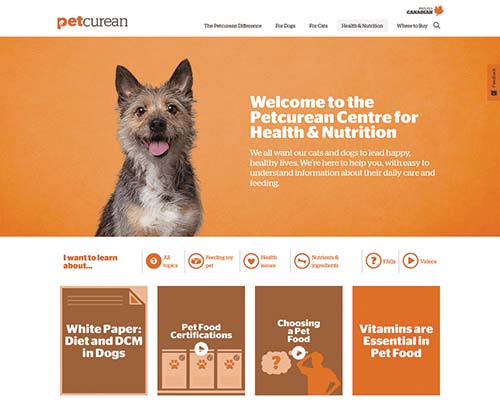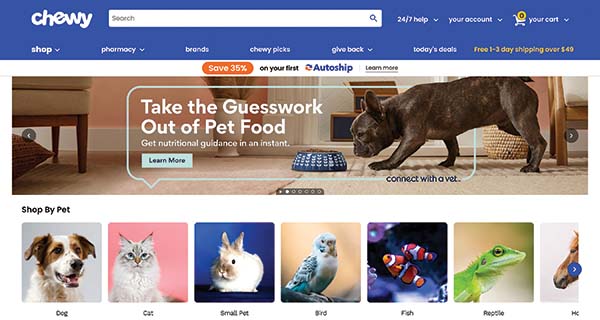This article was published in the March 2022 issue of Pet Food Processing. Read it and other articles from this issue in our March digital edition.
The COVID-19 pandemic has accelerated the growth of e-commerce in the pet sector, and an increasing number of pet owners now enjoy the convenience and affordability of shopping online for pet products and supplies. To capitalize on this trend, pet food and treat brands are investing in e-commerce strategies to help them compete and win online. But it can be challenging for companies to stand out in the crowded pet e-commerce market.
“The e-commerce space is competitive,” said Bill Hepburn, regional sales manager, Petcurean, Chilliwack, British Columbia. “To stay top of mind in a saturated market, it is important to be involved and engaged, as well as consistent with your brand messaging to the consumer. Consumers are very knowledgeable, and they do plenty of research on the pet food and treat products they purchase. Be a constant source of knowledge on your products to help consumers do their research in determining what will work best for their pets and lifestyles.”
E-commerce challenges
Consumers are now savvier and more discerning than ever when shopping online. They’re spending more time engaging product information, reviews and discussions on social media networks before they purchase.
“Online shoppers use multiple search engines (Google, Amazon, YouTube, etc.), and also seek recommendations from friends and influencers on social media,” explained Andrew Grinch, director of growth, Woodruff Sweitzer, Kansas City, Mo. “They read multiple product reviews from various sources and have all sorts of payment methods. Being agile and finding a way to move faster than your competitors in response to changing consumer behaviors can be a challenge for many brands.”
 Offering discounts and subscription ordering opportunities online can help brands capitalize on convenience and support sales. (Source: OnlyNaturalPet.com)Aside from the challenges of staying competitive and keeping up with evolving consumer trends, there are also other issues associated with selling pet treats and food online.
Offering discounts and subscription ordering opportunities online can help brands capitalize on convenience and support sales. (Source: OnlyNaturalPet.com)Aside from the challenges of staying competitive and keeping up with evolving consumer trends, there are also other issues associated with selling pet treats and food online.
“One of the biggest challenges is just the nature of the product,” explained Andy Downs, senior content and merchandising manager, Only Natural Pet, Boulder, Colo. “Pet parents don’t always know if their pets will enjoy a food or treat, so they’re unwilling to try something new if their pet is already on a reliable diet that they can get from the store.”
Strategies for success
To stand out in the crowded pet e-commerce space, companies must be able to clearly communicate the unique benefits of their products.
“One of the key ways brands can be more competitive online and grow sales is by educating existing and potential consumers on the benefits and differentiators of your products and brand,” Hepburn said. “By providing accessible and educational information that is unique to your products for consumer research, you are helping to build your brand’s reliability and reputation. Consistency in messaging is also key as consumers get inundated with information; a strong brand message will provide clarity to your consumers in a market that is overflowing with options.”
Being nimble enough to adjust to consumer buying trends is also key for pet food and treat brands looking to win at e-commerce.
 Sharing helpful educational content for pet owners on an e-commerce site can reinforce strong branding and product expertise. (Source: Petcurean.com)
Sharing helpful educational content for pet owners on an e-commerce site can reinforce strong branding and product expertise. (Source: Petcurean.com)
“Follow and adapt to consumer trends,” Grinch suggested. “If ‘sustainable dog food’ is a trending search, highlight your brand’s sustainable practices/ingredients. E-commerce is an ideal channel to shape the shopping experience for pet owners looking for shared beliefs and dynamic content for products that align with their wants and needs, such as a pet food that doesn’t include certain ingredients or is sourced a certain way. Highlighting the right trends and keywords will aid in visibility and traffic.”
Building an e-commerce strategy that focuses on multiple channels is another way for pet food and treat brands to compete with other companies in the sector.
“Being such a crowded field, it can be hard to make headway in search engine optimization (SEO) or search engine marketing (SEM) against established websites with large marketing budgets,” Downs said. “But if you have a holistic approach that pays attention to multiple channels, including growing your email list and social media, then you can make inroads.”
Grinch agreed on the importance of a multi-channel approach and offered some insight into its impact on brand visibility.
“Sole reliance on ‘brand power’ in the e-commerce space is not enough,” he said. “Digitally savvy consumers think differently about brands and are increasingly intrigued by brands they don’t have familiarity with if that brand can give them the validation they need, such as the right price, positive reviews, a good experience and more. For consumers shopping online, their experiences with a brand in multiple channels certainly impacts a sale. At Woodruff, we use a reputation scorecard that enables us to rate a brand’s performance in key categories so that its online reputation is consistent with its promise and how customers are engaging (online or offline).”
Connection and convenience
Some strategies that have proved particularly effective for helping pet food and treat brands win at e-commerce revolve around the ability to connect with consumers.
“Content works really well for the pet space,” Downs said. “Pets are not able to tell you what they like to eat or why their skin and coat is itchy. So, a lot of pet parents use search engines to research the best way to care for their pets. If you can find a good content contributor with deep knowledge of pet care, you can begin to answer some of these questions for your customers, and even collect some new customers along the way.”
 Brands must fine-tune their e-commerce platforms for user experience, easy navigation and education to stand out in this space. (Source: WeAreWoodruff.com)
Brands must fine-tune their e-commerce platforms for user experience, easy navigation and education to stand out in this space. (Source: WeAreWoodruff.com)
Being able to personalize communication is an especially powerful way for pet food and treat brands to cut through the noise and stand out to consumers.
“Personalization is a must these days but focusing on the pet and not just the pet parent has proven to increase brand engagement significantly,” Grinch said. “Capturing pet information and using that information to make personalized communications and recommendations can help break through the clutter, increase sales, and drive customer loyalty.”
Increasing the convenience factor for consumers is another important consideration for pet food and treat brands in the e-commerce space.
“Pets will always need to be fed, so it’s not like a pair of shoes that a customer buys once a year; they’ll need pet food every month,” Downs said. “So, if you can make that easy for them, where they sign up once and get a recurring shipment, that will be a loyal customer that won’t even have to visit your website for you to make a sale.”
Subscription services, discounts, and online deals are all powerful tools that brands can use to increase convenience and facilitate transactions.
“Implementing offers like discounts, ‘subscribe and save’, BOGO, and bundling deals works really well for pet food and treat brands,” Grinch noted. “This creates convenience for customers, helps build customer loyalty, and creates an ease in the supply chain for the brand.”
Mistakes to avoid
There are a few things brands may overlook when it comes to competing in the e-commerce space, according to Hepburn.
“It’s important to implement a strong iMAP (Internet Minimum Advertised Price) policy and to partner with trusted e-commerce retailers that will help you maintain integrity and value across your brand,” he said. “This is important because we don’t want heavy discounting or low pricing to erode the brand value, or force brick and mortar partners to compete with online pricing that is ‘too low.’”
 Online-only retailers are currently dominating in the pet e-commerce space, but brands and pet specialty retailers of all sizes are bolstering their capabilities to stay competitive. (Source: Chewy.com)
Online-only retailers are currently dominating in the pet e-commerce space, but brands and pet specialty retailers of all sizes are bolstering their capabilities to stay competitive. (Source: Chewy.com)
Failure to keep on top of technological advancements in e-commerce is another mistake that can be detrimental.
“Usually, the biggest mistake I see pet food and treats brands making when competing in the e-commerce space is not keeping up with the tech,” Downs said. “You could have the greatest pet food available, but if you’re not protecting your customer’s data, or you don’t have a navigable website, customers won’t trust you or return to shop. You don’t have to become an e-commerce guru, but you should have some basic working knowledge of e-commerce fundamentals.”
A lack of customer engagement and transparency can also reflect poorly on pet food and treat brands.
“Whether good or bad, responding and engaging with customers illustrates that you want the best for their pet,” Grinch explained. “It is easy to spot a brand just trying to make money as opposed to a brand that is pet-centric. Brands that don’t provide transparency in their ingredients lists, manufacturing and other behind-the-scenes processes are missing key points in the online buying journey. Consumers want to know where their pet’s food is coming from and if it meets their standards.”
The future of pet e-commerce
Looking ahead, e-commerce in the pet space is expected to grow and evolve and pet food and treat brands must be committed to staying ahead of the curve.
“Like any other industry, the e-commerce space is constantly evolving,” Hepburn said. “It is important to be open to change and to develop plans and strategies that allow your products to grow, thrive and stay current.”
The events of the past couple of years have changed consumer habits and expectations, and as a result, brands need to be prepared to face the challenges that lie ahead.
“With COVID-19, so many customers switched over to online shopping, even for staples like groceries and pet food,” Downs said. “Now it’s a matter of catching up to what’s most important for customers; whether that’s subscription programs, faster delivery, or in-store pick-up for companies in the retail space, the service side of pet e-commerce is going to become more and more important.”
Finally, technology will continue to play an important role in shaping the future of pet e-commerce.
“Purchases via mobile devices will increase,” Grinch projected. “The ease of purchasing products through your phone, especially on social media, is becoming the norm. Apps like Instagram already offer click-to-buy options and I see this becoming more common.”
Find more articles about e-commerce in the pet product industry.




